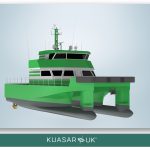Advanced Zero Emissions Ammonia Engines for Future Marine Applications led by University of Nottingham
Project partners
- University of Nottingham
- MAHLE
- Shell
Aim:
This experimental research project was concerned with comparison of two promising combustion concepts for future ammonia fuelled marine engines; namely dual fuel (diesel engine retrofit), spark ignition (new engines or deep retrofit) and novel, fast burning jet ignition combustion technology (new engines or deep retrofit) previously developed for high performance passenger car applications.
The premise was to overcome the slow burning of ammonia using the novel jet ignition system and compare such operation to advanced spark ignition operation (high ignition power and appropriate cylinder design to suit a slow burning fuel) and the competing dual fuel diesel solution (retrofit of the ammonia to an existing diesel engine, with full diesel fallback capability).
Testing facilities:
The planned work was undertaken using a state-of-the-art single cylinder research engine supplied for the project by industry partner MAHLE Powertrain Limited (used to assess both advanced spark ignition and jet ignition) and an existing Volvo “D8” diesel marine engine already available at the University of Nottingham, upgraded to dual fuel ammonia for this project.

Project outcome:
Overall, the experimental work successfully demonstrated the basic feasibility of using ammonia as a main fuel for both spark and jet ignition concepts, with operation at up to 100% ammonia fuelling viable at medium engine loads and above in a fully warm engine.
Results obtained in the Volvo D8 diesel during dual fuel operation also demonstrated that ammonia can also be utilised as a main fuel (diesel energy substitution ratios above 50%) albeit operating with significantly higher ammonia “slip” than the spark and jet ignition concepts due to deteriorated combustion efficiency.
Conclusion:
Ammonia is viable as a marine fuel albeit reliable emissions after-treatment will be critical to ensure avoidance of ammonia slip within expected tight allowable limits (e.g. ~10ppm funnel) and avoid local toxicity and wider detrimental environmental impacts.
There was also considerable learning on health and safety aspects of upgrading an engine test cell for ammonia compliance that may have direct implications on future vessel design and operation, with recommendations made that ammonia can only be used in industrial settings where strict health and safety protocols can be maintained (e.g. with failsafe automated fuel line shut-offs and engine room ventilation control).
Any enquiry, please contract Prof. Alasdair Cairns through Alasdair.Cairns1@nottingham.ac.uk.
University of Nottingham Final Report
Send download link to:


